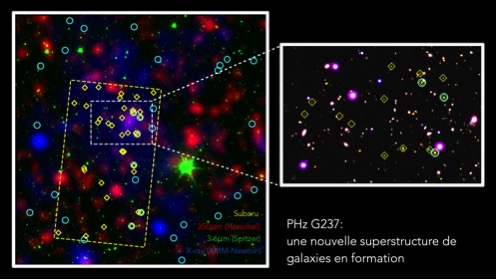A new superstructure of galaxies in formation, discovered in a cold luminous zone of the distant universe
An international team of astrophysicists involving scientists* from the University of Paris-Saclay, CNRS, the University of Toulouse III – Paul Sabatier, Aix-Marseille University and the University Claude Bernard of Lyon announced the discovery of a structure, or “proto-cluster”, dating from the most active era of the universe, and which should evolve into a supercluster of galaxies. This proto-cluster of galaxies is intensely forming stars, at a high rate that is not compatible with current models. This discovery was the subject of two publications in the journals MNRAS and A&A.
Proto-clusters of galaxies are sets of very young galaxies that are in the process of coming together under the effect of gravitation, and that will give rise to the largest gravitational structures known: clusters of galaxies in the nearby universe. The understanding of the formation mechanisms at work within these structures could prove to be invaluable for understanding the history of the universe. The results of the international team’s work, presented in two papers, provide essential information on the properties of this proto-cluster named PHz G237.01+42.50 (or G237 for short) and the galaxies that compose it.
G237 is the first spectroscopically confirmed proto-cluster from a sample of more than 2000 candidates identified by Planck, an ESA satellite launched in 2009 to probe the cosmic microwave background.
The fate of this proto-cluster of galaxies is to evolve into a complex cosmic system similar to the Virgo supercluster, a massive structure in the local universe of which our Milky Way galaxy is a part. Planck’s observations suggest a proto-cluster with a prodigious star formation rate, ten thousand times higher than that of our galaxy.

Additional observations with several ground- and space-based telescopes, including ESA’s Herschel, have confirmed its association with two strong concentrations of galaxies. Each is expected to collapse in about 10 billion years into a cluster of galaxies whose dark matter halo will have a mass of 500 to 600 trillion (million million) solar masses, equivalent to the largest galaxy clusters today.
“The 38 galaxies identified with the MOIRCS instrument on the Subaru telescope,” says Y. Koyama, lead author of one of the two studies, “are the star-forming galaxies that contain the least amount of proto-cluster galactic dust, but there may be many more members that were missed by our selection in the optical domain.”
“We estimate that the total rate of star formation in the proto-cluster is remarkably high, at least 2200 solar masses per year, and probably twice as many, based on the estimated number of dust-obscured galaxies that were not detected by optical observations but show up in the infrared,” says Dr. Mari Polletta (INAF & IRAP), lead author of the second study.
“Planck detected these candidate proto-clusters from space about a decade ago. Their confirmation and study required time, many observations with other telescopes, and hard work from researchers and students” explains Pr Hervé Dole, astrophysicist at IAS (CNRS / Université Paris-Saclay) and co-author of the two studies. “It is a great achievement to finally see one of these proto-clusters studied in detail, but many questions remain open because they challenge the models of their formation and partly our understanding of the formation of stars in the most massive dark matter halos in the distant universe. The European cosmology space mission Euclid, scheduled to be launched in 2023, is expected to identify more such structures, allowing more general laws to emerge than those based on a few individual cases.”
Other observing campaigns are underway on other Planck proto-clusters candidates. These first results are part of a larger project to better understand the assembly of massive structures such as proto-clusters of galaxies, the mechanisms behind their star formation rates, and the interaction between the dense environment and the rapid evolution of the galaxies that inhabit these dark matter halos.
(*) The laboratories involved are IAS (CNRS/University of Paris-Saclay), IRAP-OMP (CNRS/University of Toulouse III – Paul Sabatier/CNES), IAP (CNRS/Sorbonne University), LAM (CNRS/Aix-Marseille University/Cnes), and Cral (CNRS/University of Claude Bernard Lyon 1/Ens de Lyon)
Further Resources
- Scientific papers :
- “A Planck-selected dusty proto-cluster at z=2.16 associated with a strong over-density of massive Hα emitting galaxies”, authored by Yusei Koyama, Maria del Carmen Polletta, Ichi Tanaka, Tadayuki Kodama, Hervé Dole, Geneviève Soucail, Brenda Frye, Matt Lehnert, Marco Scodeggio, 2021, MNRAS, 501, L1, https://ui.adsabs.harvard.edu/abs/2021MNRAS.503L…1K/abstract, https://arxiv.org/abs/2008.13614
- “Spectroscopic observations of PHz G237.01+42.50 : a galaxy protocluster at z=2.16 in the Cosmos field”, authored by M. Polletta, G. Soucail, H. Dole, M. D. Lehnert, E. Pointecouteau, G. Vietri, M. Scodeggio, L. Montier, Y. Koyama, G. Lagache, B. L. Frye, F. Cusano, and M. Fumana, A&A, 2021, A&A, 654, A121, https://arxiv.org/abs/2109.04396
IRAP Contacts
- Geneviève Soucail, genevieve.soucail@irap.omp.eu
- Etienne Pointecouteau, etienne.pointecouteau@irap.omp.eu
- Ludovic Montier, ludovic.montier@irap.omp.eu






